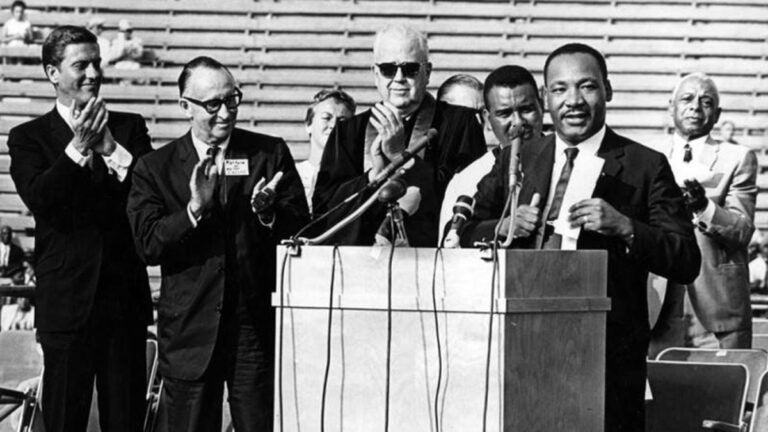
Martin Luther King Jr.’s moments and mission in Los Angeles
The civil rights leader visited USC and its surrounding neighborhoods throughout the late ’50s and ’60s in his quest to improve the lives of Black Americans.
This story was originally published on Jan. 14, 2021.
When thinking about the legacy of Martin Luther King Jr., iconic images probably flood your mind. Black-and-white photos from the late 1950s and 1960s document desegregation marches in Alabama, his speeches in Washington, D.C., and protests stretching as far west as Chicago. But do you picture Los Angeles as part of that scene?
It turns out that the influential Baptist minister and activist traveled often to L.A. during his all-too-short life. He visited USC and other universities, as well as the Los Angeles Memorial Coliseum and other South L.A. landmarks, speaking out for the rights of Black Americans and raising funds to support the fight for civil rights. USC students and faculty members also took up King’s call to (nonviolent) arms against racism, participating in marches and packing Bovard Auditorium to hear him speak at USC in 1967. Here are just a few highlights from King’s visits to L.A., the civil rights movement he advanced and the USC students he inspired.
1959
Dancing for Equal Rights
USC students were invited to attend the “integration ball” at a union hall a mile from the USC University Park Campus near Flower Street and West Adams Boulevard. For a $1 donation, students could dance and support the Youth March for Integrated Schools in Washington, D.C. King was honorary chair of two such marches, held in 1958 and 1959, that called for integrating U.S. schools. The Youth March also sent a petition to the president and Congress that proclaimed equal rights “the central moral issue of our times.” The National Student Association, which included USC’s student government, signed the petition.
1960
The Democratic National Convention
King traveled to Los Angeles for the Democratic National Convention, where John F. Kennedy was set to be nominated as the Democratic candidate for president. Fronting a group of 5,000 protestors, King and other activists rallied at the Los Angeles Sports Arena near the University Park Campus. Their goal: to make civil rights a prominent part of the Democratic platform. They partly succeeded, as the Democrats acknowledged the civil rights movement and committed to enforcing the Civil Rights Acts of 1957 and 1960.
Stand Up for Sit-ins
On Feb. 1, four Black students sat down at an F.W. Woolworth lunch counter in Greensboro, N.C., and waited to be served. The diner staff refused. When the young men were asked to leave, they stayed in a show of passive resistance. It ignited a sit-in movement that reached as far as Southern California: In July, King joined a protest at the F.W. Woolworth on Broadway in downtown Los Angeles, about 2 ½ miles northeast of the University Park Campus.
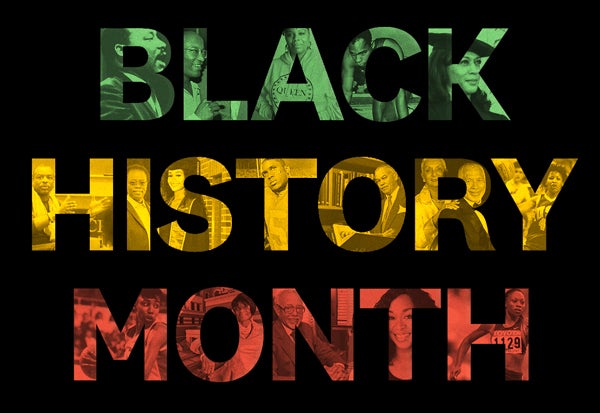
1961
Freedom Rallies
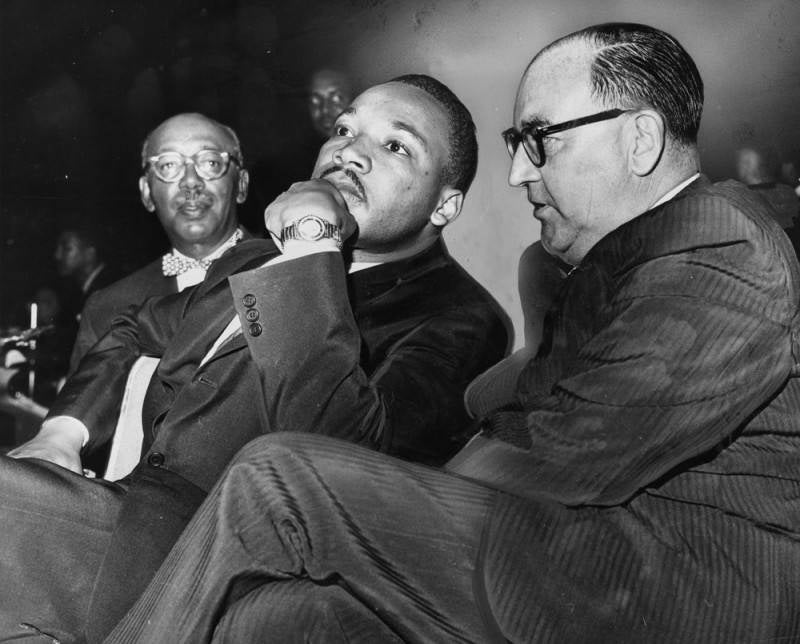
King had allies in Los Angeles, especially among fellow ministers. Rev. John Doggett, a pastor in nearby Pasadena, chaired Freedom Rallies in L.A. starting in 1961 to raise awareness of King’s work. Doggett presented King with a fundraising check at an event at Bovard Auditorium on the USC University Park Campus as part of the effort. On June 18, 1961, King spoke before tens of thousands at the Sports Arena. The events helped bankroll a growing tactic in the civil rights movement: nonviolent direct action.
The L.A. rallies supported civil rights sit-ins and high-visibility protests such as the Freedom Rides. The first Freedom Riders were 13 Black and white men and women who boarded Greyhound and Trailways interstate buses to challenge segregation policies in the South. They set out from Washington, D.C., in May 1961, intending to ride to New Orleans. They encountered violence, abuse and arrest. One of the vehicles was even firebombed. King backed the Freedom Rides but didn’t participate in them, frustrating some activists who called for stronger protests against discrimination. But in the end, the momentum spurred by the Freedom Riders led to important changes in access to travel.
1963
Celebrities Behind the Cause
Wrigley Field — once the home of the Los Angeles Angels — hosted King on May 26 for the Los Angeles Freedom Rally. Nearly 40,000 people packed the stadium at what’s now the site of the Gilbert Lindsay Recreation Center, less than 2 miles southeast of the University Park Campus. According to the California African American Museum, the rally “was part of a full day of support for racial equality and attracted celebrities Dorothy Dandridge, Rita Moreno, Paul Newman, Sammy Davis Jr., Dick Gregory and other notable supporters of King. Earlier that day, King attended First African Methodist Episcopal church and was the guest of honor for an evening reception where Los Angeles luminaries such as Marlon Brando were in attendance.”
1964
King at the Coliseum
In May, King spoke before more than 15,000 people at the Los Angeles Memorial Coliseum — home of Trojans football — as part of the Religious Witness for Human Dignity interfaith event. Less than a year after his famous “I Have a Dream” speech, King called on Californians to stand on the side of justice. At issue: a fair housing law that the state had approved in 1963. After the law’s passage, several groups mounted a campaign to repeal it through a proposition on the Nov. 1964 ballot. Just as Congress was considering landmark national civil rights legislation that year, King asked Californians to reject discrimination in their state and vote no on Proposition 14. Residents approved the initiative despite his pleas, but it was eventually deemed unconstitutional.
A Man of Faith
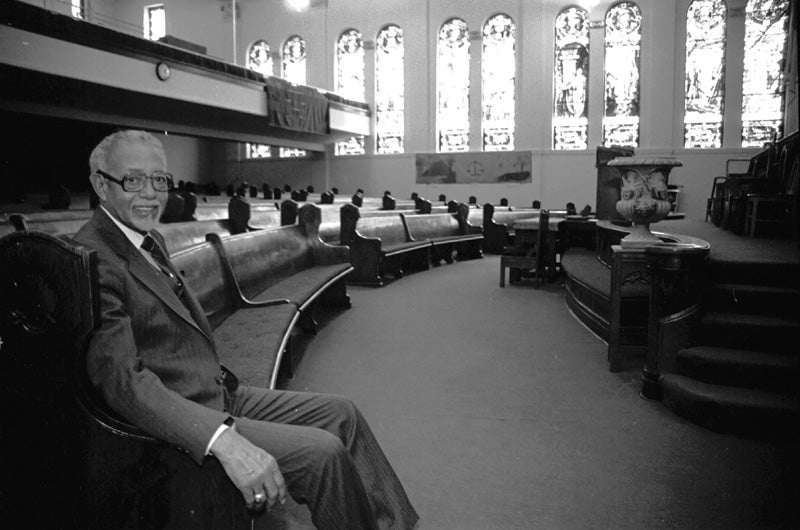
King gave a guest sermon at Second Baptist Church on Griffith Avenue and 24th Street, about a mile east of the University Park Campus. Among his topics: the importance of avoiding hatred and violence in the quest for civil rights, and the relevance of the church to the movement. He often visited the site — Los Angeles’ oldest African American church.
Second Baptist Church’s pastor, Rev. Thomas Kilgore Jr., was a longtime friend and was an important catalyst for King’s involvement in Los Angeles. Kilgore, who had helped organize the historic civil rights march on Washington, D.C., in 1963, also helped establish the Southern Christian Leadership Conference’s Los Angeles office, the only chapter west of the Rockies. He later became deeply involved in the campus community as director of the USC Office of Community Affairs. He served as advisor to three university presidents and established USC’s Black Alumni Association, which offered scholarships to minority students.
1965
Los Angeles in Turmoil
In August, Los Angeles police arrested 21-year-old Marquette Frye on suspicion of drunk driving. During the struggle, police hit Frye over the head; they also arrested his brother and mother. Mounting tension between the police and residents in South L.A. set off six days of unrest known as the Watts Riots or Watts Rebellion. In the aftermath of the unrest, King arrived in Los Angeles, keen to listen to Black residents talk about their struggles. The frustration, anger and calls for violent action he heard troubled him: They further reinforced his commitment to the importance of equitable economic opportunities and better living conditions to fight poverty among Black Americans.
Trojans Go to Alabama
Only a few months after winning the 1964 Nobel Peace Prize, King led protestors in Alabama on a march for voting rights. On March 24, three USC faculty members, two campus ministers and nearly 20 USC students flew there on specially chartered planes to meet hundreds of marchers descending on the state capitol. They would walk the final miles of a 54-mile journey from Selma to Montgomery alongside other protestors.
Activists had been pushing for equal voting rights for Blacks in Selma since January. The effort began with mass arrests and culminated in a brutal police attack on protestors in early March dubbed “Bloody Sunday.” Amid a public outcry, President Lyndon B. Johnson submitted voting rights legislation to Congress. On March 21, King and fellow protestors set out from Selma by foot in support of the right to vote. They arrived in Montgomery four days later.
As social workers, we should be primarily concerned with civil rights as well as other social problems
Jerry Gaines
Nine of the USC students were from USC’s social work school. “As social workers, we should be primarily concerned with civil rights as well as other social problems,” said Jerry Gaines MSW ’66, one of the USC students who marched in Alabama, in the Daily Trojan. The students hoped to meet the civil rights leader who inspired them, but with so many participants, they doubted it would happen. Said Gaines: “I think the press of humanity will limit our chances to see Rev. King.”
1967
Bovard and the Bomb Scare
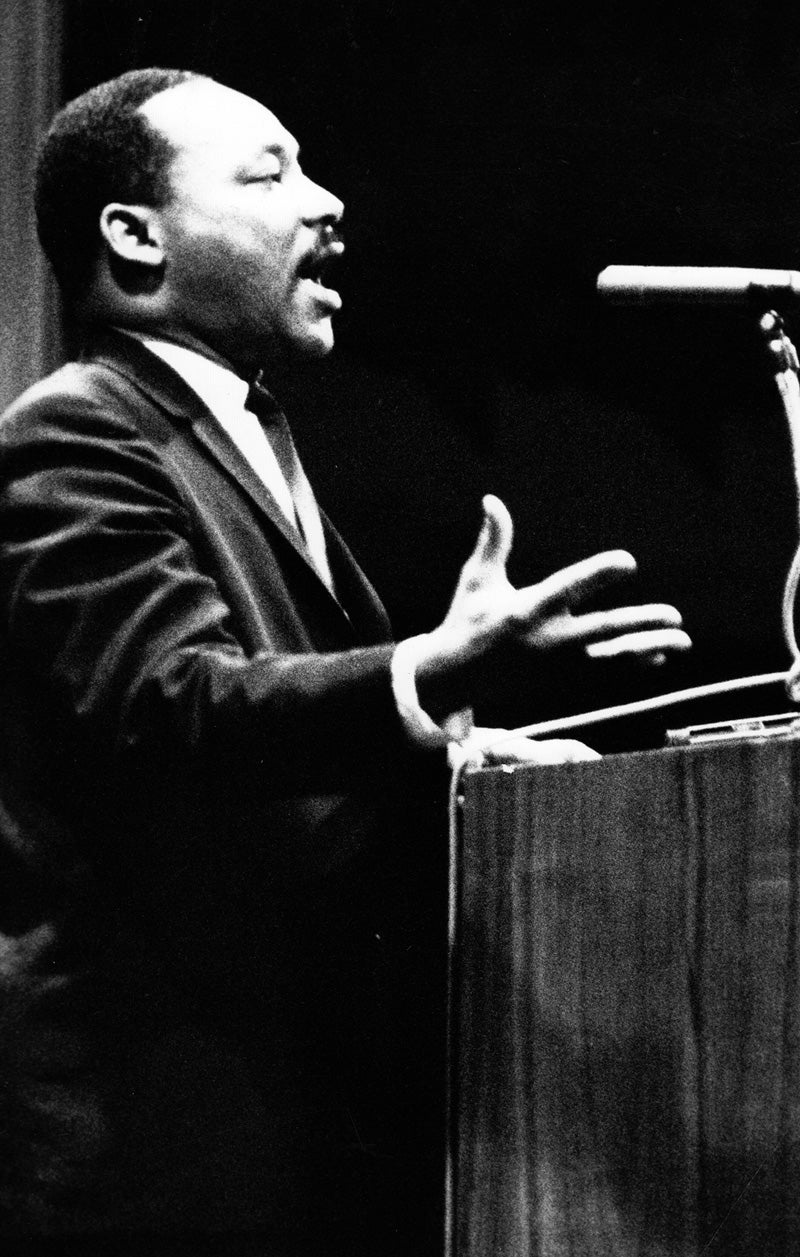
An exhausted King left his Los Angeles hotel room on Oct. 16 and slipped into a waiting car. The destination: Bovard Auditorium, where he was to address students as part of the university’s Great Issues Forum speaker series. He began his speech shortly after 8 p.m., according to the Daily Trojan, but within 30 minutes, a bomb scare evacuated the standing-room-only crowd of more than 1,800 from the building. No matter. He was used to these interruptions, and after police had cleared the site and students filed back in, King continued.
His speech at USC testified to the uneasiness of the time. In April, King had led his first demonstration to push the U.S. out of the Vietnam War, and some activists criticized him for conflating that cause with the civil rights movement. By June and July, racial tension escalated across the country. In what became known as the “long, hot summer of 1967,” unrest related to social inequalities erupted in cities from Atlanta to Chicago. At the same time, King — the man who had been jailed for his protests in earlier years — was being accused by Black Power activists of taking too little action.
King’s words at Bovard reflected the pressure he faced to take a more aggressive stance against endemic racism while maintaining his relationship with national political leaders. “We must make nonviolence much more militant,” King told the crowd, according to the Daily Trojan. “We have to escalate it, to use the military term. We must be able to dislocate cities with massive civil disobedience and without the loss of life and property. We must make the power structure react. Riots do no good. They just relieve the guilt of the white community.”
1968
A People Mourn
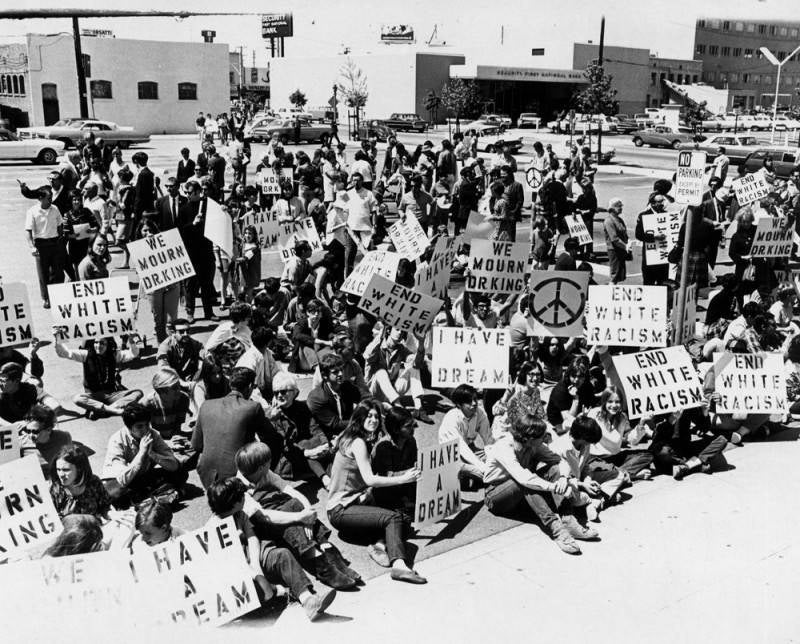
On April 4, King was assassinated as he stood on the balcony of his second-floor hotel room in Memphis, Tenn. He was only 39 and unable to see the fruits of his leadership, although his ideas live on in the countless people he inspired.
On the University Park Campus, USC students who had gathered to hear him only six months earlier now mourned his loss. Editors of the Daily Trojan wrote these words in their April 17 issue:
“This is America, baby, land of the free. Wake up and see that it’s free. Wake up and see that it’s not just your America. It’s free America. It’s their America too.
It’s a country not of madmen but of free men. Free men well-clothed, well-fed, well-educated and well-housed. Men with as free a chance as any other men to move forward in their own life. Free men under the law, yes, but also free in love with all others. One free people under God.
It is necessary, also, to focus upon what must be done. In the individual conscience, the hate that spawns murder, and the dislike that brings discrimination, must be removed. … USC is in a position to make an impact for understanding. To walk away from this opportunity is to kill a chance for justice. In America, the need is simply to make things right. Massive amounts of time and money may be required, but time and money mean much less than lives. And the lives of many, we must remember, were not served by Dr. King unless we follow his tragedy with his glory.
That would be the most satisfying for all.”



